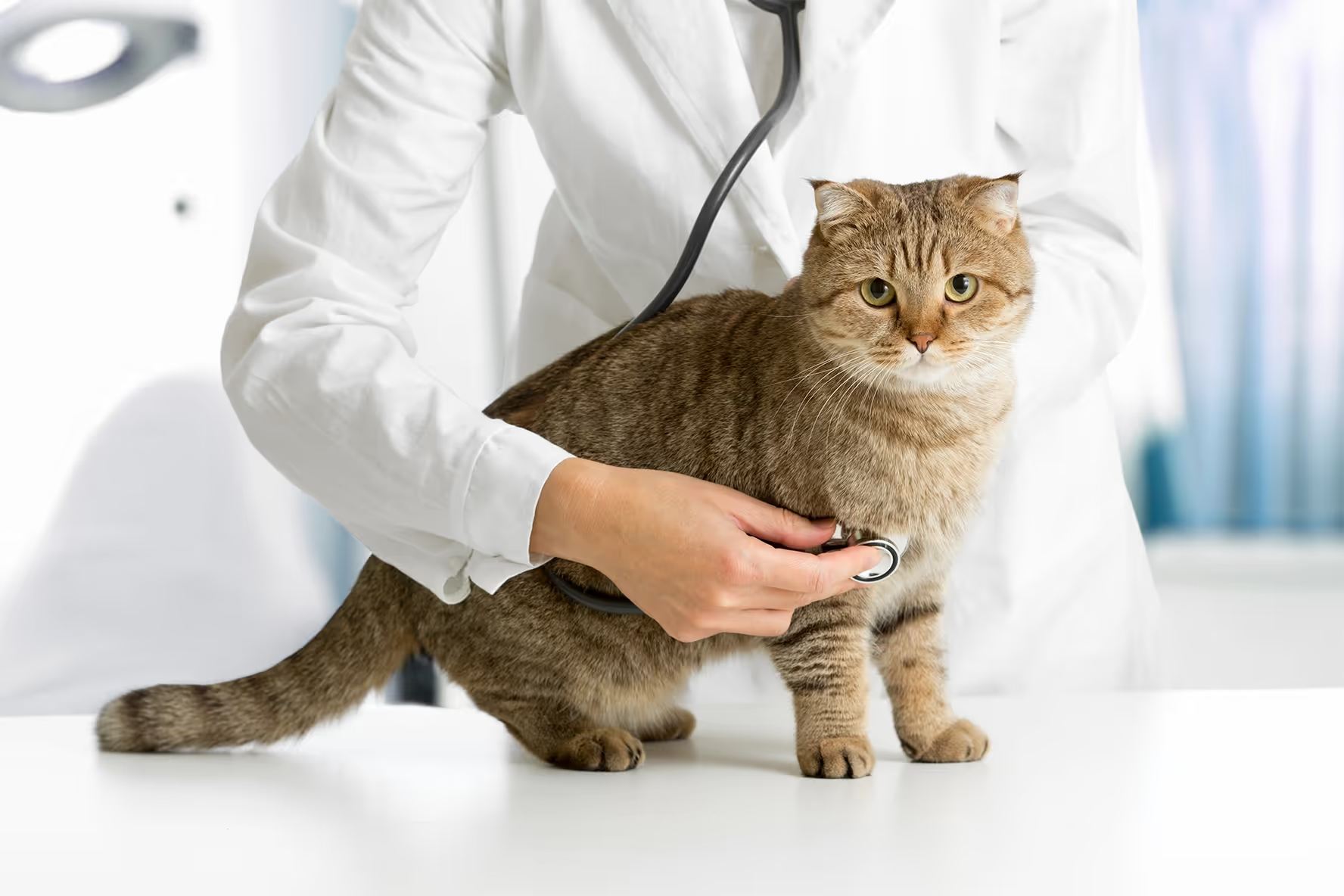
What is feline lymphoma?
Lymphoma is a type of cancer that affects cells within the body, known as lymphocytes. These cells circulate throughout the body, making lymphoma a cancer that can affect various systems. Lymphocytes interact with multiple areas in the body, including the thymus gland, spleen, bone marrow, and stomach tissues, contributing to the body's defense against threats. Different cases of lymphoma may manifest differently, but the most frequently diagnosed form in cats is gastrointestinal lymphoma.
You can learn more about feline lymphoma in general in our blog here.
Survival times on average for cats with lymphoma
Survival times for a cat diagnosed with lymphoma vary greatly due to several factors: the type of lymphoma, the stage of that cancer, where it is located, and which treatment is ultimately chosen–-of which there are many choices.
We have more information on the different treatment options that you can learn about here.
High grade lymphoma in cats
High grade lymphoma is one of the more aggressive forms of lymphoma that can develop. For cats that are diagnosed with a high grade form of lymphoma, over half of patients can achieve a full remission with a chemotherapy protocol. Other cats that only obtain a partial remission, still often end up having a higher quality of life than they had before chemotherapy.
The average survival rate in cats is 6-9 months for high grade lymphoma, but there are many factors that can alter that rate.1 A cat’s feline leukemia status, the degree that the lymphoma has advanced at the start of treatment, where the primary site of the cancer is, etc.
Low grade lymphoma in cats
Low grade lymphoma is slower to develop than high grade lymphoma and leads to a different approach when it comes to chemotherapy medication treatment. Low grade or lymphocytic gastrointestinal lymphoma in cats is treated with chemotherapy pills and requires fewer office visits than the high grade form.
Typically 80-90% of cats with a low grade lymphoma will respond positively to treatment, though it can take a couple of weeks before there are signs of that response.
The average survival time for a low grade lymphoma is about 1.5-2 years, and that can also be affected by outside factors the same as high grade lymphoma.1
Benefits of palliative care for cats with lymphoma
Palliative care is designed to help your cat feel as comfortable and happy as they can. The goal is to keep your pet comfortable and give you and your family time to spend with your cat. Palliative care is not treating the underlying disease or cancer, but instead trying to keep pets comfortable for the time they have left.
Palliative care can be a great option for pet parents who are either not in a financial position to put their furry friend through advanced chemotherapy treatments, or for those whose cats have had other health problems in the past and therefore may not be strong enough to partake in chemotherapy treatment.3 Some forms of cancer and even lymphoma can become advanced and resistant to therapy until only palliative care remains.
Palliative care options
Generally, the main focus of palliative care is your cat’s comfort, meaning limiting the pain that they experience on the day to day. Many palliative care plans will use multiple focuses of managing pain, from medications to therapies to nutritional supplements.
Some palliative care therapies can include pain medications like anti-inflammatories or steroids. Also, drugs designed to block nerve pain. Antibiotics can be used as needed when tumors become infected. Appetite stimulants are medications to help increase eating when are pets no longer feel like it. Anti-nausea and anti-diarrhea medicine helps when pets are having stomach upset. Bland and easily digestible diet can also help an upset tummy.
Creating a safe environment in your home is another element of palliative care. By limiting the potential for your home to be an obstacle to your cat’s comfort, you can maximize their mobility and protect them from injuries.
Ways to create a safer environment for your cat in the home is to add non-skid surfaces to floors so that they won’t have trouble moving around the house. Raising their food and water dishes to minimize the potential for back pain, and keeping their food and water easily accessible. You can also provide ramps to get to areas that they may have been able to jump to in the past but no longer can, and adjust the walls on their litter box to be lower so access is easier and more manageable.
Palliative care is an important option for many pet parents and it can often be the best option for your cat and for your family. Discuss with your vet the goals that you have for your pet’s end-of-life journey and what you hope to have them experience when they’ve gotten the bad news of a terminal illness. It can be surprising how helpful it is to set goals for your cat’s life and achieve them when it comes to the grieving process later on.4
How to decide to euthanize
The decision to put a pet to sleep will never be an easy one. You have poured your heart into caring for your pet. Whether it’s been a month or a decade, you and your cat have a bond that is hard to put aside when it comes to making that impossible decision to relieve their pain, but also lose them from your side. There is also a huge sense of guilt when euthanizing a pet because we do not make this decision for people. It is important to recognize your feelings and process them.
Signs your cat may be nearing the end of their life
There are a few signs that your cat may be ready to pass on that you may be able to tell based on their quality of life. A lymphoma diagnosis, or any other terminal disease, is not an instant deciding factor that your cat is out of time.
Like people, there are things that cats can do to show that they are enjoying their life, even through the struggles that they might be having. Paying attention to behavior and daily activities is a good way to gauge your cat’s general wellbeing.
Looking at your cat’s quality of life
- Eating and Appetite
- If your cat is still eating regularly they may feel mostly fine. But if your cat is experiencing a reduced appetite, struggles to enjoy their food, or is simply struggling to perform the action of eating, it may be a sign that their quality of life is decreasing.
- Drinking water
- If you don’t notice much difference in the amount of water that your cat is consuming, they may feel mostly fine. But both drinking excess water, and not drinking enough water can be signs that your cat is not feeling their best or isn’t feeling a strong enough drive to take care of themself.
- Expressing pain or discomfort
- Lymphoma can create discomfort for some patients, but not all. If your cat has had some pain or discomfort during their diagnosis, then showing signs of minor discomfort (i.e. licking themselves, being quieter than normal or looking around when certain areas of their body are touched) may mean that their quality of life could not be overly affected by that pain and discomfort. However, if your cat is regularly whimpering or screaming when areas of their body are touched, that may be a very bad sign. Especially for cats with alimentary lymphoma, or gastrointestinal lymphoma. Contact your vet if they are expressing pain in major ways, it can be a sign of a medical emergency for some patients.
- Hygiene
- Using the litter box at a standard rate for them, not having accidents outside of the litter box or having incontinence problems in the litter box, are signs that they are managing their symptoms. If they are having accidents or using the bathroom less you may need to take that into consideration along with their other quality of life behaviors. Anything that is out of the ordinary and causes you any concern may be a reason to contact your vet.
- Bathing is also a sign of a cat’s quality of life. The regularity that they are taking the time to give themselves a bath is a sign that they are still hanging on and happy to be around. Lessening the regularity of their bathing, or not noticing their body’s status either with matting or developing sores are signs that they may be moving away from taking care of themselves.
- Play, joyfulness, and movement
- If your cat is still excited to play, that is generally a great sign for their mental wellbeing, even if their mobility may not let them play to the level that they once could. Changes in their excitement and enthusiasm to play may be a sign that their quality of life is depleting.
- Walking and navigating the home confidently can also be a sign that your cat’s quality of life is manageable for them. When they start to have more difficulty getting around on level areas, there is cause for concern.
- Hiding
- Cats will start to hide in unusual places when they do not feel well. It is important to pay attention to where your cat is lying in the house and if it is in one of their normal locations.
- The ratio of good to bad days
- As a pet parent, you’ll know the signs of your cat having a good day or a bad day. Near the end of any pet’s life the ratio of good days to bad days starts to favor bad days; knowing that your cat is no longer having regular or consistent good days can be a sign that it might be near their time. It’s a hard decision to make for any situation, but knowing that your cat is having mostly bad days may take some of the difficulty off your shoulders.
There are degrees that your cat’s quality of life may go down or up when they are navigating lymphoma in their day to day. A cat having one symptom of a lower quality of life doesn’t instantly negate all of the positives that they may be experiencing in another category.2
Take the time you need before moving on
Losing a pet is a hard thing to go through. There is an added weight of being the decision maker when their time comes to an end that is hard for anyone to manage. When you have to put your pet down to be able to protect them from pain it can create more pain for you right after.
You may feel an urge to fill the gap that your lost pet has left in your life, but take some time to grieve before adding another furry family member to your home. Every cat has their own individual personality and while there are cats everywhere that may remind you of your pet, they won’t be the same as your cat.
The grieving process looks different for everyone, you may feel ready to move on earlier or later than other people, and it’s up to you to be honest with yourself about when it feels right. Just try not to rush it for the sake of the happiness of your future pet. And there is no shame in not being ready to, or simply choosing not to have another pet after losing one.
ImpriMed helps pet parents make the best decisions for their pet’s lymphoma journey, find out more about what we do here.
References:
- https://www.ethosvet.com/blog-post/feline-lymphoma
- https://www.codapet.com/blog/when-to-euthanize-a-cat-with-end-stage-lymphoma
- https://petcureoncology.com/deciding-when-to-euthanize-a-cat-with-cancer/
- https://hospital.cvm.ncsu.edu/services/small-animals/cancer-oncology/oncology/feline-lymphoma/
- https://vcahospitals.com/know-your-pet/palliative-care-for-cats


